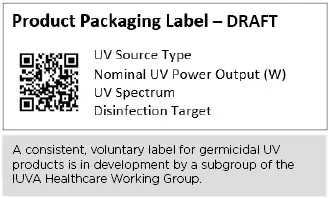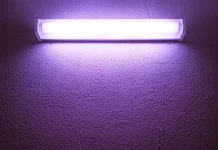Mairead Smith, principal project engineer, ECRI
Troy Cowan, IUVA Healthcare/UV Working Group facilitator
This quarter, we invited Mairead Smith, lead of our UV Labeling Team, to capture the drivers behind the initiative and summarize the team’s efforts to date in drafting labeling standards for UV disinfection sources and UV devices. The plan is that this will result in an ANSI standard for acceptable UV disinfection labeling across the commercial and regulatory spectrum. Many thanks to the entire Labeling Team for their insightful and essential contributions to date. Good stuff. – Troy
Introduction
The COVID-19 pandemic has highlighted and intensified several existing trends in the ultraviolet disinfection market. First, it reiterated the need for rapid, no-touch disinfection methods. Second, it increased demand for ultraviolet disinfection products across healthcare, commercial and consumer markets. Third, it blurred the lines between products intended for different markets and applications. As this all progressed, there was an influx of new products from various sources.
To complicate matters, there are no ways to credibly compare products, one against the other. The EPA, FDA and FTC all have regulations on the books against labeling products with anything that is false or misleading, but with little definition of what adequate labels should contain. As a result, some vendors have made vague, false, or misleading claims, without providing verifiable product specifications or supporting test results, and suffer no repercussions. Sometimes, due to the lack of clear definitions, labels are categorized by the regulators as vague, false, or misleading, despite the best of intentions.
One result of these rapid changes has been widespread confusion: Confusion among regulators regarding how germicidal UV products should be regulated. Confusion among purchasers as to the reputability of various manufacturers and the ability of a UV product to meet the needs of an application. Confusion as to the efficacy of the products in combating the spread of COVID-19. And confusion among the users of products about how to use the product in a safe and effective manner.
Almost certainly, some potential germicidal UV purchasers have decided to go in other directions, such as bleach disinfectants or HEPA air purifiers – in part due to lack of confidence in the UV products that they were considering purchasing. This is a missed opportunity to employ the full range of disinfection solutions to combat the ongoing threats of COVID-19 and other infectious diseases.
The Purpose of a Germicidal UV Label
A consistent, voluntary label for germicidal UV products, such as the label currently being developed by a small subgroup of the IUVA Healthcare Working Group, can help relieve the confusion faced by many stakeholders. Inspired by the LED Lighting Facts initiative of 2009, which supported the reporting of product performance in a fair and comparable way, the Germicidal UV label aims to improve communication of product capabilities among manufacturers, vendors, purchasers, end users and regulators.
The label recommends standardized language, and when appropriate, consistent presentation of information, to support a common understanding of what is being reported. It relies on standards (both existing and in development) to define the method of testing and the format for reporting results, to ensure that results are comparable among various products.
Scope
The label is intended to apply to products that emit germicidal wavelengths of ultraviolet radiation: specifically, products that emit radiation in the wavelength of 200 to 280 nm (to include broad-spectrum xenon sources) that are intended for disinfection purposes.
The label will be modified to meet the needs of different product categories, including completed devices (e.g., room disinfection towers, handheld wands, upper air UV fixtures) and lamps/components.
The first iteration of the label is oriented toward “open-ended” or “outward-facing” products – products that emit UV radiation into the space around them. Enclosed products, such as disinfection chambers or air purifiers with an internal UV lamp, are expected to be addressed by a second iteration.
The Label Concept
In its current draft format, the label consists of two main components:
- The simple product packaging label, including a QR code
- Detailed supplement product information, accessible online via the QR code on the product packaging
The aim of these components is to balance ease of access for readers with the flexibility needed by manufacturers.
The product packaging label is simple and easy to read, with very basic information including:
- UV source type (e.g., LED, low-pressure mercury lamp)
- Nominal UV power output (W)
- Disinfection target (e.g., air, surface), when applicable
The detailed supplemental product information, hosted online and accessed via the QR code on the packaging label, is proposed to consist of the following sections:
General Properties
a. UV source type
b. Nominal power draw
c. Nominal UV power output
Emission Properties
a. Peak irradiance at 1m
b. Spectral power distribution – presented in graphical
form
c. Continuous or pulsed emission (with pulse frequency,
when applicable)
d. Ramp-up time to 90% nominal UV power output
e. Angular radiant intensity distribution – presented in
graphical form
Safety
a. Applicable AGCIH Threshold limit values®
b. Applicable general and electrical safety requirements,
including UL and CIE certifications, etc.
c. Chemical hazards, including ozone and lamp disposal,
and the applicable federal regulations
Directions and Next Steps
This label draft has been developed by a small subgroup of the IUVA Healthcare Working group, including representatives from industry, academic institutions and NIST. The group has begun reaching out to the National Electrical Manufacturers Association (NEMA) to explore paths to establish the label as a voluntary ANSI standard, which device and component manufacturers can choose to adhere to.
The label is a means for reporting measurement and test results produced by applying UV voluntary industry consensus standards to the product under consideration. For example, the peak irradiance measurements for a 265 nm UV LED, reported in the supplemental information, would be based on measurements taken using standard ANSI/IES/IUVA LM-92-22, recently published and activated. This labeling effort is expected to continue to evolve and is dependent on work that is currently underway or planned by the various standards development organizations and related associations currently involved in developing UV standards (e.g., IUVA, IES, ASHRAE and NEMA).
Conclusions
The label system envisioned is intended to provide consistent, accurate and verifiable information for infection control professionals, facility managers, public health officials, regulators and the interested public. The labels will facilitate informed decisions when selecting the germicidal UV device that best fits their needs to assist in preventing the next pandemic.
In the end, it’s all about prevention. It’s all about saving lives.
The IUVA Healthcare/UV Working Group endeavors to promote the acceptance of UV disinfecting technologies as a credible, valued part of environmental management throughout the healthcare industry. In this column, the UV community will be updated on these efforts and the latest information on UV technology as it pertains to the healthcare industry.
Contact: Troy Cowan, troy@visionbasedconsulting.us






